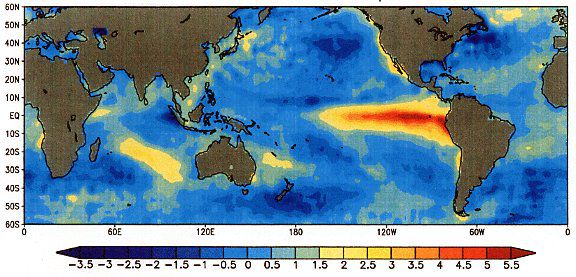-
 Callisto
Callisto
-
 Glioma
Glioma
-
 Bald cypress
Bald cypress
-
 Fairing
Fairing
-
 Biometry
Biometry
-
 Shiga toxin
Shiga toxin
-
 Supercritical fluid
Supercritical fluid
-
 Quartz
Quartz
-
 Web-footed bird
Web-footed bird
-
 Substitution
Substitution
-
 Chalazion
Chalazion
-
 Botnet
Botnet
-
 Nymphosis
Nymphosis
-
 Supercooling
Supercooling
-
 eMule
eMule
-
 Firewire
Firewire
-
 Nanoparticle
Nanoparticle
-
 Magnetic moment
Magnetic moment
-
 Sclerite
Sclerite
-
 Invisible Web
Invisible Web
-
 Ventilation
Ventilation
-
 RC2
RC2
-
 Convergent evolution
Convergent evolution
-
 Smallpox virus
Smallpox virus
-
 Earth Summit
Earth Summit
-
 Monoclinic system
Monoclinic system
-
 Magma
Magma
-
 Milky Way
Milky Way
-
 Thermocline
Thermocline
-
 Fanconi anaemia
Fanconi anaemia
El Niño
El Niño is a climatic phenomenon whose origin is not understood very well. As opposed to La Niña, it causes a rise in temperature of the surface water (about 10 metres) in the East Pacific Ocean, around the equator (see the map below).
El Niño, the bad boy of the climate
The name El Niño - which means " child " in Spanish -refers to Jesus, since this phenomenon reaches its peak around Christmas. Peruvian fishermen gave this name to the corresponding cold marine current.
This phenomenon was discovered in the 1920s by Sir Gilbert Walker, an English physicist who demonstrated the Southern oscillation linked to El Niño.
The climatic consequences of El Niño
Just like La Niña, El Niño does not affect all parts of the globe in the same way.
Normally, in the Pacific Ocean, around the equator, the trade winds blow from the East (America) to the West (Australia and Asia). This has the effect of pushing the warm surface waters to the West, where it consequently produces heavy precipitation (due to the heat and humidity) and the rise of cold water along the American coast.
The El Niño climatic phenomenon corresponds to an inversion of the trade winds in the Pacific. © ide.fr
But when the Earth is affected by El Niño, trade winds tend to reverse. Thus the waters near Australia and Asia are colder , which causes droughts. Hurricanes form in the middle of the Pacific and affect Polynesia. Finally, the water along the American coast warms, causing an increase in precipitation and a rarefaction of fish on the surface, because warm waters are not favourable to the proliferation of nutrients.
El Niño years
The last occurrences of the phenomenon were in 2009-2010, 2006-2007, 2002, 2003, 1997-1998, 1994-1995, 1990-1993, 1986-1988, 1982-1983, etc.
 El Niño caused temperature anomalies in 1997. The warm colours show a positive anomaly (therefore an increase in temperature). One can see that the temperature increased across the Western Pacific and along the American coasts. © NOAA, public domain
El Niño caused temperature anomalies in 1997. The warm colours show a positive anomaly (therefore an increase in temperature). One can see that the temperature increased across the Western Pacific and along the American coasts. © NOAA, public domain
Latest
Fill out my online form.



